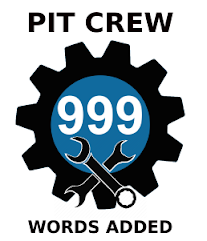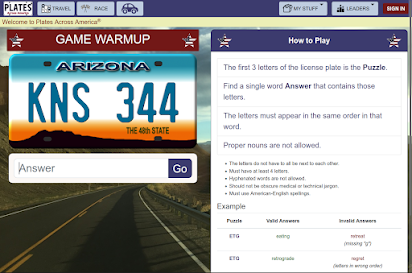 |
| Achievements Page |
|
When you play Plates Across America®, you will earn "badges". Some of these are directly related to the single-player game's Travel Goals, some are earned for achievements in the two-player game and a few others for players that make contributions to the game.
Since it takes a while to accumulate all the different types of badges, we thought it might be interesting for newer players to see the full set of our badges and to find out how each one is awarded. We add new badges from time to time, so there may be new ones by the time you read this article.
Achievement Levels and Coloring
For all the badge types, there is a range of achievement levels. These levels will correspond to some minimum value needed to earn the badge. As you reach higher threshold values, the color of the badge reflects the increasing achievement level. The coloring scheme for the achievement levels is shown in the image below for the Miles Traveled Badge.
Types of Badges
Miles Traveled Badges
We start with the simplest one to understand: the miles traveled badge. This is based on the total number of miles you have traveled while playing the single player mode. The achievement level thresholds for this badge are 100, 250, 500, 1000, 2500, 5000 and 10000 miles.
Collection Badges
The core concept for winning the single player mode is the "Travel Goal". You can earn Collection Badges as you reach travel goals. Examples of travel goals are:
- states you have traveled through;
- license plates you have collected;
- scenic routes you have traveled; and
- locations you have visited for the different "location types".
Here are examples of some of the badges you can earn as you achieve travel goals.
Location Badges
As you travel in the single player game, you pass through (or near) cities, landmarks and other man-made, natural and geological places of interest. You can collect these places to reach different Travel Goals. The kinds of places you can collect include:
- state capitals,
- national parks,
- national monuments,
- bridges,
- caves,
- ghost towns,
- mountain passes,
- tunnels, and
- waterfalls.
Two Player Game Badges
When two players compete against each other, we call this a "Race". In a race, each player is given the same 10 puzzles. There is a time limit for each puzzle. The player that enters the best answers wins the race. You can get badges for competing in and winning enough races.
User Contribution Badges
The final set of badges we have are not for in-game achievements, but are for players that have helped improve our game. There are a few ways users can help to improve the game:
Dictionary Words
It is more challenging than you might think to build a good dictionary, and even harder to get a large group of people to agree what should and should not be included in a dictionary. Therefore, we acknowledge that at any point in time, our dictionary will not be complete and it will evolve. Because of this, players can suggest words to be added to our dictionary.
When your answer is flagged as being incorrect because it is not in our dictionary, we provide a link you can use to submit it to us. We review these submissions and if the word is accepted and added, we acknowledge your contributions with the "Pit Crew" badge.
City Facts Badge
As you travel in the single player game, your pass through and near cities, towns and other locations of interest. To add to the feeling of virtual traveling and to provide players with some interesting context on the places being visited, we have a "City Facts" feature that gives some interesting trivia, facts and history of the locations.
There are tens of thousands of places across the country, so it is hard to know about each and every one of them. However, if a player is acquainted with the area, they may know something interesting about it that we do not. In the game, we allow players to contribute and share that knowledge by sending it to us for review. We will research the suggestion and if it is accepted, we acknowledge the effort with the "Historian" badge and also give attribution to the person that submitted it.
Early Adopters Badge
Plates Across America® has evolved a lot since the early versions. We constantly iterate to make the game better and better. We can only do that by having real players try out the game and give us feedback. Some give us explicit feedback, while others provide it indirectly by what they do and do not do as they play the game.
To thank those people that have played earlier versions, we give them the "Trailblazer" badge. The earlier a player joined, and the more they have played, the higher the badge level.
Closing Comments
We hope this overview of the game's badges was informative. If you have never played Plates Across America® before, you can start acquiring badges by playing here:
https://platesacrossamerica.com
Happy Travels!









































